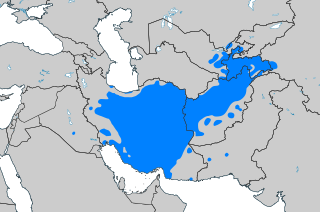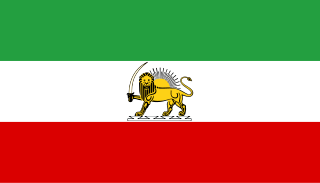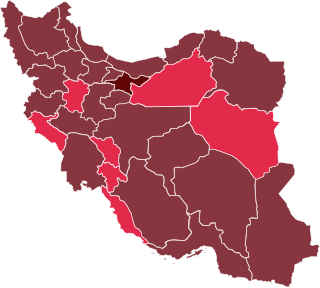
The Baháʼí Faith is a religion teaching the essential worth of all religions and the unity of all people. Established by Baháʼu'lláh in the 19th century, it initially developed in Persia and parts of the Middle East, where it has faced ongoing persecution since its inception. The religion is estimated to have over five million adherents, known as Baháʼís, spread throughout most of the world's countries and territories.

Persian, also known by its endonym Farsi, is a Western Iranian language belonging to the Iranian branch of the Indo-Iranian subdivision of the Indo-European languages. Persian is a pluricentric language predominantly spoken and used officially within Iran, Afghanistan and Tajikistan in three mutually intelligible standard varieties, namely Iranian Persian, Dari Persian and Tajiki Persian. It is also spoken natively in the Tajik variety by a significant population within Uzbekistan, as well as within other regions with a Persianate history in the cultural sphere of Greater Iran. It is written officially within Iran and Afghanistan in the Persian alphabet, a derivation of the Arabic script, and within Tajikistan in the Tajik alphabet, a derivation of Cyrillic.

Iran, also called Persia, and officially the Islamic Republic of Iran, is a country in Western Asia. It is bordered to the northwest by Armenia and Azerbaijan, to the north by the Caspian Sea, to the northeast by Turkmenistan, to the east by Afghanistan, to the southeast by Pakistan, to the south by the Persian Gulf and the Gulf of Oman, and to the west by Turkey and Iraq. Iran covers an area of 1,648,195 km2 (636,372 sq mi), with a population of 83 million. It is the second-largest country in the Middle East, and its capital and largest city is Tehran.

The Iran–Contra affair, popularized in Iran as the McFarlane affair, the Iran–Contra scandal, or simply Iran–Contra, was a political scandal in the United States that occurred during the second term of the Reagan Administration. Senior administration officials secretly facilitated the sale of arms to the Khomeini government of the Islamic Republic of Iran, which was the subject of an arms embargo. The administration hoped to use the proceeds of the arms sale to fund the Contras in Nicaragua. Under the Boland Amendment, further funding of the Contras by the government had been prohibited by Congress.

The Iran–Iraq War was a protracted armed conflict that began on 22 September 1980 when Iraq invaded neighbouring Iran. The war lasted almost eight years, ending in a stalemate on 20 August 1988 when Iran accepted a UN-brokered ceasefire. Iraq's rationale for the invasion was primarily to cripple Iran and prevent Ayatollah Ruhollah Khomeini from exporting the 1979 Iranian Revolution movement to Shia-majority Iraq and threaten the Sunni-dominated Ba'athist leadership. Iraq had also wished to replace Iran as the dominant state in the Persian Gulf, which was before this point not seen as feasible by the Iraqi leadership due to pre-revolutionary Iran's colossal economic and military might, as well as its close alliances with the United States and Israel. The war followed a long-running history of border disputes, as a result of which Iraq had planned to annex Iran's oil-rich Khuzestan Province and the east bank of the Shatt al-Arab.
The Persians are an Iranian ethnic group that make up over half the population of Iran. They share a common cultural system and are native speakers of the Persian language, as well as languages closely related to Persian.

Sayyid Ruhollah Musavi Khomeini ( khom-AY-nee, khohm-; Persian: سید روحالله موسوی خمینی [ɾuːholˈlɒːhe xomejˈniː];, also known in the Western world as Ayatollah Khomeini, was an Iranian politician, revolutionary, and cleric. He was the founder of the Islamic Republic of Iran and the leader of the 1979 Iranian Revolution, which saw the overthrow of the last Shah of Iran, Mohammad Reza Pahlavi, and the end of the 2,500-year-old Persian monarchy. Following the revolution, Khomeini became the country's Supreme Leader, a position created in the constitution of the Islamic Republic as the highest-ranking political and religious authority of the nation, which he held until his death. Most of his reign was taken up by the Iran–Iraq War of 1980–1988. He was succeeded by Ali Khamenei on 4 June 1989.

Zoroastrianism or Mazdayasna is one of the world's oldest continuously practiced religions. It is a multi-faceted faith centered on a dualistic cosmology of good and evil and an eschatology predicting the ultimate conquest of evil with theological elements of henotheism, monotheism/monism, and polytheism. Ascribed to the teachings of the Iranian-speaking spiritual leader Zoroaster, it exalts an uncreated and benevolent deity of wisdom, Ahura Mazda, as its supreme being. Historical features of Zoroastrianism, such as messianism, judgment after death, heaven and hell, and free will may have influenced other religious and philosophical systems, including Second Temple Judaism, Gnosticism, Greek philosophy, Christianity, Islam, the Baháʼí Faith, and Buddhism.

Tehran is the capital of Iran and Tehran Province. With a population of around 8.7 million in the city and 15 million in the larger metropolitan area of Greater Tehran, Tehran is the most populous city in Iran and Western Asia, and has the second-largest metropolitan area in the Middle East. It is ranked 24th in the world by the population of its metropolitan area.

The history of Iran, which was commonly known until the mid-20th century as Persia in the Western world, is intertwined with the history of a larger region, also to an extent known as Greater Iran, comprising the area from Anatolia, the Bosphorus, and Egypt in the west to the borders of Ancient India and the Syr Darya in the east, and from the Caucasus and the Eurasian Steppe in the north to the Persian Gulf and the Gulf of Oman in the south.

The Iran hostage crisis was a diplomatic standoff between the United States and Iran. Fifty-two American diplomats and citizens were held hostage after a group of militarized Iranian college students belonging to the Muslim Student Followers of the Imam's Line, who supported the Iranian Revolution, took over the U.S. Embassy in Tehran and seized hostages. The hostages were held for 444 days from November 4, 1979, to January 20, 1981.

The Imperial State of Iran, also known as the Imperial State of Persia from 1925 to 1935, was a sovereign state in Western Asia which was bordered by Turkey and Iraq to the west, the Soviet Union to the north, Afghanistan and Pakistan to the east and shared a maritime border with Oman toward the south. With a population of 37 million in 1979, Tehran served as its capital city.

The Iranian Revolution was a series of events that culminated in the overthrow of the Pahlavi dynasty under Shah Mohammad Reza Pahlavi, and the replacement of his government with an Islamic republic under the Grand Ayatollah Ruhollah Khomeini, a leader of one of the factions in the revolt. The revolution was supported by various Islamist and leftist organizations and student movements.

Sayyid Ali Hosseini Khamenei is a Twelver Shia Marja' and the second and current supreme leader of Iran, in office since 1989. He was previously President of Iran from 1981 to 1989. Khamenei is the longest serving head of state in the Middle East, as well as the second-longest serving Iranian leader of the last century, after Shah Mohammad Reza Pahlavi.

Mahmoud Ahmadinejad, born Mahmoud Sabbaghian, is an Iranian politician who served as the sixth President of Iran from 2005 to 2013. He was also the main political leader of the Alliance of Builders of Islamic Iran, a coalition of conservative political groups in the country, and served as mayor of Tehran from 2003 to 2005.

The Iranian peoples or the Iranic peoples, are a diverse Indo-European ethno-linguistic group. identified by their use of the Iranian languages and other cultural similarities.

Mohammad Reza Pahlavi, also known as Mohammad Reza Shah, was the last Shah (King) of Iran from 16 September 1941 until his overthrow in the Iranian Revolution on 11 February 1979. Due to his status as the last Shah of Iran, he is often known as simply the Shah.

Aryan is a term which was originally used as a self-designation by Indo-Iranian peoples in ancient times, in contrast to "non-Indo-Aryan" or "non-Iranian" peoples. The idea of being an Aryan was religious, cultural and linguistic, not racial. Although the root *h₂er(y)ós is most likely of Proto-Indo-European (PIE) origin, the use of Arya as an ethno-cultural self-designation is only attested to among Indo-Iranian peoples, and it is not known if PIE speakers had a term to designate themselves as a group.

The Joint Comprehensive Plan of Action, known commonly as the Iran nuclear deal or Iran deal, is an agreement on the Iranian nuclear program reached in Vienna on 14 July 2015, between Iran and the P5+1 together with the European Union.

The COVID-19 pandemic in Iran is part of the worldwide pandemic of coronavirus disease 2019 caused by severe acute respiratory syndrome coronavirus 2. On 19 February 2020, Iran reported its first confirmed cases of infections in Qom. The virus may have been brought to the country by a merchant from Qom who had travelled to China.
















